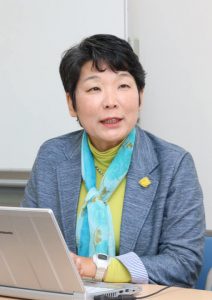Views on Ukraine invasion from A-bombed Hiroshima’s perspective: Mie Oba, 57, associate professor, Fukuyama City University
Apr. 24, 2022
Communicate reality to young children
by Shuhei Inomata, Staff Writer
The preamble to the constitution of the United Nations Educational, Scientific and Cultural Organization (UNESCO) declares, “Since wars begin in the minds of men and women, it is in the minds of men and women that the defences of peace must be constructed.” We must not let those words remain a mere slogan. At times such as these, we need to emphasize peace education for children from an early age.
Even young children are witnessing the war in Ukraine through media coverage. Most important now is to sow seeds to ensure the mistake of war is not repeated. Children might struggle to understand the war and its background. But their being able to consider how people with differing opinions can shake hands and respect each other would be an important first step in preventing such acts of barbarism in the future.
Previously, in one of my seminars at the university, the students and I produced a picture-story show based on the testimony of an A-bomb survivor. We put everything into the creation of the show to ensure that the material could last and be used for one-hundred years to reject the absurdity of depriving people of their daily lives. We continue to perform the picture-story show today. I believe that people of the A-bombed cities of Hiroshima and Nagasaki, who refused to amplify their hatred for and the idea of retaliation against the United States, hold the power to create peace by their calls to the rest of the world.
As an executive member of the Japanese National Committee of Organization Mondiale Pour I΄Éducation Préscolaire, or OMEP, I hear about the grim situation in Ukraine, including such stories as a pediatrician who carried a gun while holding a baby in his arms, and of a pregnant woman forced to give birth in a subway station while bombs fell around them.
There are age-appropriate ways to convey such tragic events. When we created the picture-story show, a conflict arose among us about whether the tragedy should be expressed vividly or described indirectly. Eventually, we opted for the latter option. The A-bomb survivor whose story we convey, however, was dissatisfied with our decision: “The A-bombing was hell on earth. Your pictures fail to communicate the reality.” However, the tragedy cannot be communicated to children if they refuse to watch.
Adults need to consider how to tell children about things happening in Ukraine without altering the essence of the message. As adults, we need to respond based on our own experiences and ideas when children ask, “Why” or “How come”? We must not sit back as onlookers with the attitude that the conflict is happening somewhere far off.
War mercilessly violates the human rights of children. The right to life for Ukrainian children is now under attack. They are being deprived of their right to grow and receive an education. Taking the situation seriously, we must communicate the reality to Japanese children in a way that is appropriate.
Profile
Mie Oba
Born in Fukuyama City in 1965, Ms. Oba completed her doctoral degree at the University of Tsukuba. She specializes in childhood education. After studying at the University of Tours Graduate School, in France, she assumed her current position as an associate professor at Fukuyama City University in April 2011. In 2019, Ms. Oba became the first Japanese person to win OMEP’s Education for Sustainable Development (ESD) Award for her work involving a performance with picture cards of a story involving an A-bombed tree.
(Originally published on April 24, 2022)








